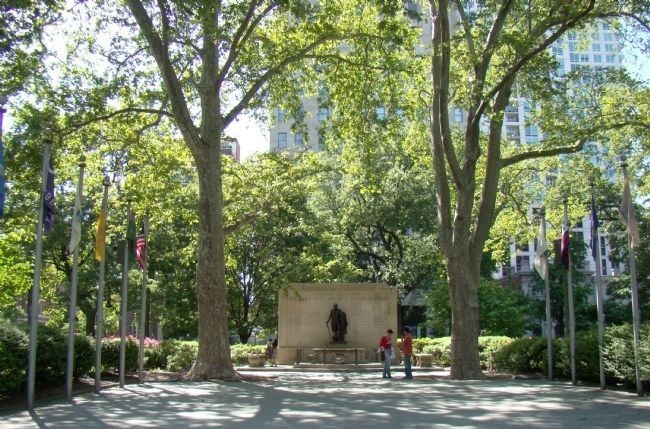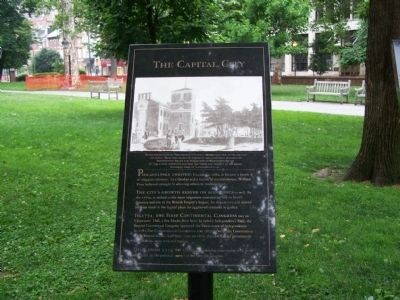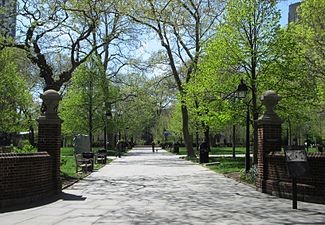Washington Square
Introduction
Text-to-speech Audio
Images
Tomb of the Unknown Soldier in Washington Square (image from Historic Marker Database)

Capital City marker in Washington Square (image from Historic Marker Database)

Washington Square (image from Wikimedia Commons)

Backstory and Context
Text-to-speech Audio
Philadelphia's Washington Square, set aside by the city's founder, William Penn, is home to the Tomb of the Unknown Soldier, honoring Revolutionary fighters, as well as to the Bicentennial Moon Tree. Historically, the 6.4-acre square has been used as a pasture, hay field, fishing hole, burial ground, revival meeting ground, public park, and site of the oldest extant publishing house in America [1; 2].
History of the SquareWhen William Penn founded Philadelphia in 1682, he planned the city with a grid system for the streets and five squares set aside for public parks, knowing that green space was both healthy and, in preventing the spread of fire, practical for a large city [2; 7]. Surveyor Thomas Holme laid out the city plan based on Penn's ideas, including the five squares. Originally known as Southeast Square, Washington Square may have been intended as a public park, but from 1704-1794 served, instead, as a potter's field (pauper cemetery) and for the burial of strangers who died unidentified in the city, such as travelers and sailors [7; 13]. Other early burials included victims of suicide (who could not be buried in churchyards), African Americans, Catholics, epidemic victims, and convicts [10; 13; 14]. Most of the deceased were buried without coffins, simply bound in canvas. In spite of its rather somber role in the city, Southeast Square was frequented by many living visitors. Some came for the excellent fishing (at the time, two good fishing creeks and a pond were present, none of which remain today) and duck hunting [14]. Local African Americans, both free and enslaved, called it "Congo Square," and came to perform rites in the vein of the Mexican Day of the Dead, holding dances and leaving food and libations of rum for their deceased [10; 13]. By the 1760s, the Square was doubling as a pasture, and in 1775 the Walnut Street Jail was established at the northeast corner of the Square [14].
During the American Revolution, both the jail and the burying grounds would be filled with both British and Revolutionary soldiers. The first of the burials came in the form of 20 by 30 foot mass graves along 7th and Walnut Streets and along the south side, where between 1776 and 1777 over 2,000 casualties from Washington's Army were interred. Some had died in battle, many more of small pox and other diseases, according to a letter written by John Adams to his wife, Abigail [12; 13; 14]. The British occupied Philadelphia later in the year, locking prisoners of war in the Walnut Street jail, where they were starved, beaten, and allowed to freeze to death by their captors; one survivor, Jacob Ritter, recalled rats as a delicacy, as the alternatives were eating grass, leather scraps, and "pieces of a rotten pump," [13]. An estimated dozen prisoners per day died under these conditions, and were buried in mass graves within the Square [12; 13; 14]. The Colonial Army overtook the British at Philadelphia in 1778, reoccupying the Square and the jail. As a result, many British soldiers are also buried at Southeast Square [13].
After the war, the publishing house of Lea & Febiger, founded by Mathew Carey in 1785, was originally located at 6th and Locust, facing the Square. Though operating in a different location now, Lea & Febiger is the oldest extant publishing company in the United States. The Walnut Street Jail was reformed in 1790, becoming the site of the first American criminal rehabilitation programs. Reforms included the separation of male and female prisoners, adult and juvenile prisoners, and debtors and felons. One of the debtors, Robert Morris, had helped finance the Revolution and was a close friend of George Washington, who came to visit him often while Morris was in prison. Prisoners could work off their sentences by training with artisans and producing goods in prison workshops, which resulted in a decline in repeat offenses. It was from the prison yard, too, that on January 9, 1793, the first flight in America was launched by French aeronaut Jean Pierre Blanchard. President George Washington provided Blanchard with a passport authorizing him to land his hot air balloon wherever necessary [14].
Later in the same year, a much grimmer event occurred in Philadelphia: a Yellow Fever epidemic which killed thousands. The death toll is estimated at between 5,000 (or one tenth Philadelphia's population at the time) and 10,000 (one fifth the population). Mass graves in Southeast Square were once again opened and filled with shrouded bodies [13; 14]. Though we now know Yellow Fever spread via the Aedes mosquito, in the 18th century both physicians and laypeople believed its source to be "miasmas", or infectious vapors in the air, particularly from malodorous sources such as rotting food, swamp waters, and mass graves [12; 13]. Thus, the Square was finally closed as a cemetery in 1793 [12].
In 1815, the city began improvements to the Square. A public walk was added and over 60 species of trees were planted, and Southeast Square was renamed Washington Square in 1825. The area was leveled, removing the pond and streams where people had fished in the 17th and 18th centuries, and geometric paths, benches, ornamental fencing, and lamps were installed in 1833 [1; 2; 14]. Efforts to construct a monument for the Revolutionary soldiers buried anonymously in the Square's mass graves began in 1832. A cornerstone was even laid the following year, but not enough funds were raised to pay for a statue, and the project was abandoned for the next hundred years [11].
In 1835, the Walnut Street Jail closed, replaced three years later with an Egyptian Revival building designed by John Haviland for the Pennsylvania Fire Insurance Company (in turn, replaced by the current two buildings of the Penn Mutual Insurance Company, which retain the original Haviland facade). Other institutions and companies sprang up on the properties adjoining Washington Square during the 19th century. The Pennsylvania Bible Society at 701 Walnut Street opened their Bible House in 1808, and are the oldest Bible society in the United States. The first Italianate building in the nation, designed by John Notman, was built in 1845 at 219 South 6th Street: the National Historic Landmark Philadelphia Athenaeum, an institution promoting literary and scientific endeavors. Its reading room has been visited by Charles Dickens, Edgar Allan Poe, and Giuseppe Garibaldi. The Philadelphia Savings Fund Society (PSFS), founded as a benevolent institution with no stockholders, was established at its first headquarters in 1816, and at its second headquarters on the Square in 1869. The Italianate PSFS bank building design was selected from a design competition, won by architect Addison Hutton of the firm Sloan and Hutton. Lea & Febiger was joined by other publishing companies at Washington Square: J. B. Lippincott was established in 1789, The Farm Journal in 1827, W. B. Saunders in 1888, and Curtis Publishing in 1891. Each of these companies built headquarters at the Square in the early 20th century; Lippincott's Italianate designed by William B. Pritchett in 1900, Curtis' Beaux Arts designed by Edgar Seeler in 1910 (featuring a Tiffany glass mosaic of Maxfield Parrish's painting The Dream Garden), and the Farm Journal's cornucopia-sporting headquarters in 1911 on the site of the Orange Street Friends' Meeting House. In addition, the Art Deco former headquarters of America's oldest advertising company, N. W. Ayer & Son (founded in 1869) was built on the Square in 1928 [14].
Some other interesting neighbors of the park include 245 South 6th Street, where General Count Groucy retired after fleeing Napoleon's Army when he failed to show up at the Battle of Waterloo; and the home of Philadelphia author Christopher Morley, which later became the Christopher Morley Inn, central to the art community of Washington Square for a time. A Colonial Revival mansion, designed by G. Edwin Brumbaugh, was constructed in 1957 for Mayor Richardson Dilworth and his wife Ann, between the Athenaeum and the Lippincott Publishing building [14].
Brumbaugh had also been the architect in charge of the restoration of Washington Square in 1954-1956 [14]. The Square was finally to have its Revolutionary soldier memorial. Archaeologists were employed to rediscover the graves of the soldiers. Several pauper and individual burials were excavated before a mass grave was located. Within this grave, a twenty-year-old male with a head wound evident on the skull (likely from a musket ball) was found in the remnants of an oak coffin. This anonymous young soldier, who could either have been British or Colonial, was selected for reinterment in the monument's tomb. The monument also includes an eternal flame and a bronze sculpture of George Washington, replicated from Jean Antoine Houdon's original piece commissioned by Thomas Jefferson [13].
Marker and Monument Inscriptions:
Washington Square
Washington Square (6.4 acres) is one of the original five squares laid out by William Penn and his surveyor Thomas Holme in the plan for the city of Philadelphia in 1682. First designated as Southeast Square, it was renamed Washington Square in 1825 in honor of America's most illustrious Revolutionary War General and First President of the United States, General George Washington. / During the American Revolution, Washington Square served as a burial ground for over 2,000 Continental soldiers and British prisoners. It has remained an open space public parkland since 1816 as have three of the other original squares - Franklin, Logan and Rittenhouse. Center Square, at Broad and Market Streets, is now the site of Philadelphia's landmark City Hall. / Park Rules: No dogs, bicycles or alcoholic beverages are permitted in the Square. Your cooperation in helping protect and maintain this historic area is requested and appreciated [4].
Welcome to Washington Square
Founder William Penn had a plan for Philadelphia. He wanted a prosperous, bustling city with straight, orderly streets. He also set aside five squares, establishing parks for the public. Both ideas influenced the design of many later American towns and cities. / Southeast Square, renamed for George Washington in 1825, only slowly lived up to Penn's ideal. In the 18th century, it served as a burial ground and pasture. In the 19th century the city added trees, walks, benches, lamps, and an ornamental fence. An 1846 guidebook described the Square as "beautiful and fashionable." / In the mid-2oth century, residents added the memorial to Washington and unknown soldiers of the American Revolution. It remains the Square's centerpiece. / The Square's importance to the nation was formally recognized when it became part of Independence National Historical Park at the beginning of the 21st century [3].
Penn's Plan
William Penn learned many lessons
in life. Living in 17th century England taught him that open space offered
breathing places for great cities and also slowed the spread of fire.
He applied what he had learned to Philadelphia. He insisted on a site that was
"navigable, high, dry, and healthy." He wanted "uniform"
streets with "houses built in a line." He envisioned "gardens,
orchards, or fields" around the houses. Penn wanted "a green country
town which will never be burnt, and always be wholesome." / Penn's city plan, drawn up by surveyor Thomas Holme included five public
squares, the center one for "houses for Publick affairs" and the
others as green oases carefully placed throughout the developing city [7].
The Capital City
Philadelphia thrived. Founded in 1682, it became a haven of religious tolerance. As a Quaker and a victim of discrimination, William Penn believed strongly in allowing others to worship freely. / The city's growth rested on economics as well. By the 1770s, it ranked as the most important commercial city in North America and one of the British Empire's largest. Its importance and central location made it the logical place for aggrieved colonists to gather. / In 1774, the First Continental Congress met in Carpenters Hall, a few blocks from here. In nearby Independence Hall, the Second Continental Congress approved the Declaration of Independence. In 1787, the Constitutional Convention met there to write the Constitution of the United States. And from 1790 to 1800, the new federal government used the city as its national capital. / Thus from 1774 to 1800, Philadelphia functioned, with brief interludes, as the political capital of the emerging nation [8].
A Fashionable Promenade
In the 17th century, when the Square first appeared in the city plan, streams drained into a deep gully in front of you. Then, beginning in 1833, geometric paths invited visitors into a leveled square planted with hundreds of trees. / By 1846, Washington Square, with its seats, lamps and ornamental fence, had dramatically changed from the "offensive nuisance" of the 18th century into "a beautiful and fashionable promenade" where adults strolled and children played marbles. / In 1853, American landscape architect Andrew Jackson Downing's Rural Essays praised Washington Square, reporting that it had "more well grown specimens and different species of forest trees than any similar space of ground in America." [9]
In Memory of the Many American Soldiers
who, during the War for Independence, died prisoners of war in the jails of Philadelphia, and were buried in this ground during the years 1777 and 1778. / Erected 1900 by Quaker City Chapter, Daughters of the American Revolution [6].
Linked in Memory
A statue of the most famous
American, George Washington, stands near the Square's center. It keeps a vigil
at the tomb of an unknown soldier who died during the War for Independence.
Revolution linked them in life. This shrine joins them in our memory.
In 1825 the city renamed its five public squares. This one became Washington
Square. Organizers raising money for a suitable monument hoped for success as
the 1832 centennial of the president's birth approached. They actually laid a
cornerstone in 1833, but failed to raise enough cash for a statue.
Success waited for over a century. A new drive begun in 1953, finally funded
the joint memorial that you see today.
Freedom
is a Light
For Which Many Men Have Died in Darkness
In unmarked graves within this square lie thousands of unknown soldiers of Washington’s Army who died of wounds and sickness during the Revolutionary War. / “The independence and liberty you possess are the work of joint councils and joint efforts of common dangers, sufferings and success.” —Washington’s farewell address Sept. 17, 1796 [11]
Sorrow and Joy
Until the 19th century this was
often a sorrowful place. Many people knew it as a potters field, a
"publick burying place for all strangers," for soldiers, sailors,
convicts, and the "destitute whose remains are walked over." A lonely
Acadian refugee found eternal rest here, along with epidemic victims,
Catholics, and African Americans.
Only free and enslaved African Americans brought a measure of mirth to this
Square which, according to oral tradition, they called "Congo
Square." One 19th century historian recorded that during fairs and
holidays perhaps as many as a thousand Black Philadelphians came here to dance
"after the manner of their several nations in Africa, speaking and singing
in their native dialects...over the sleeping dust below." He also wrote of
those from Guinea (a term once used to encompass several African areas)
"going to the graves of their friends early in the morning, and there
leaving them victuals and rum." [10]
Congregation of the Dead
On January 27, 1777, Deborah Norris wrote to her friend Sally Wister of a "shocking sight." Large pits are dug in the negroes burying ground (Washington Square), and forty or fifty (soldiers) coffins are put in the same hole. / Throughout that winter, disease thinned the ranks of the American army. John Adams, a member of the Continental Congress meeting in Independence Hall, visited the Square in April 1777. He spent an hour "in the congregation of the dead." The graves of the soldiers, perhaps 2,000 he had been told, "are enough to make the heart of stone melt away." / During the British occupation later that year, American captives died every day. Their bodies were dragged into carts, hauled here and dumped into the earth. / Only after yellow fever ravaged Philadelphia in 1793, did burials in the Square stop. Some believed that graves emitted miasmas, vapors suspected as sources of epidemics [12].
Sycamore planted May 6, 1975 from
seed carried to the moon by Astronaut Stuart A. Roosa on Apollo XIV, February
1971.
National Aeronautics & Space Administration
Forest Service USDA
Pennsylvania Horticultural Society
Honoring Earth's green world of trees [5]
